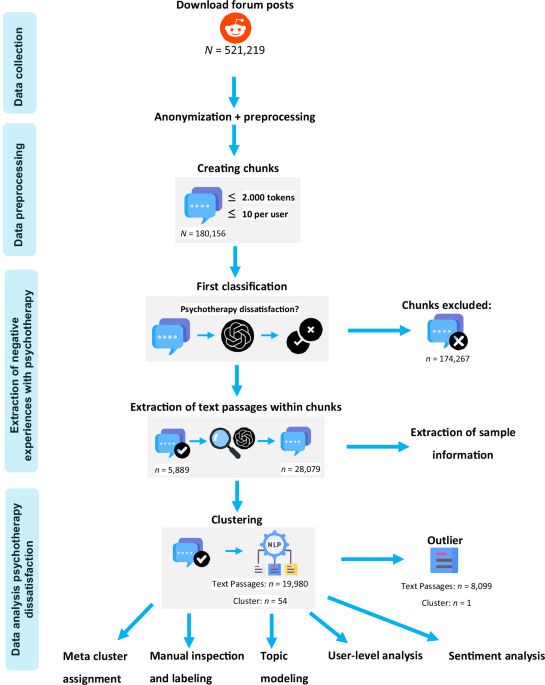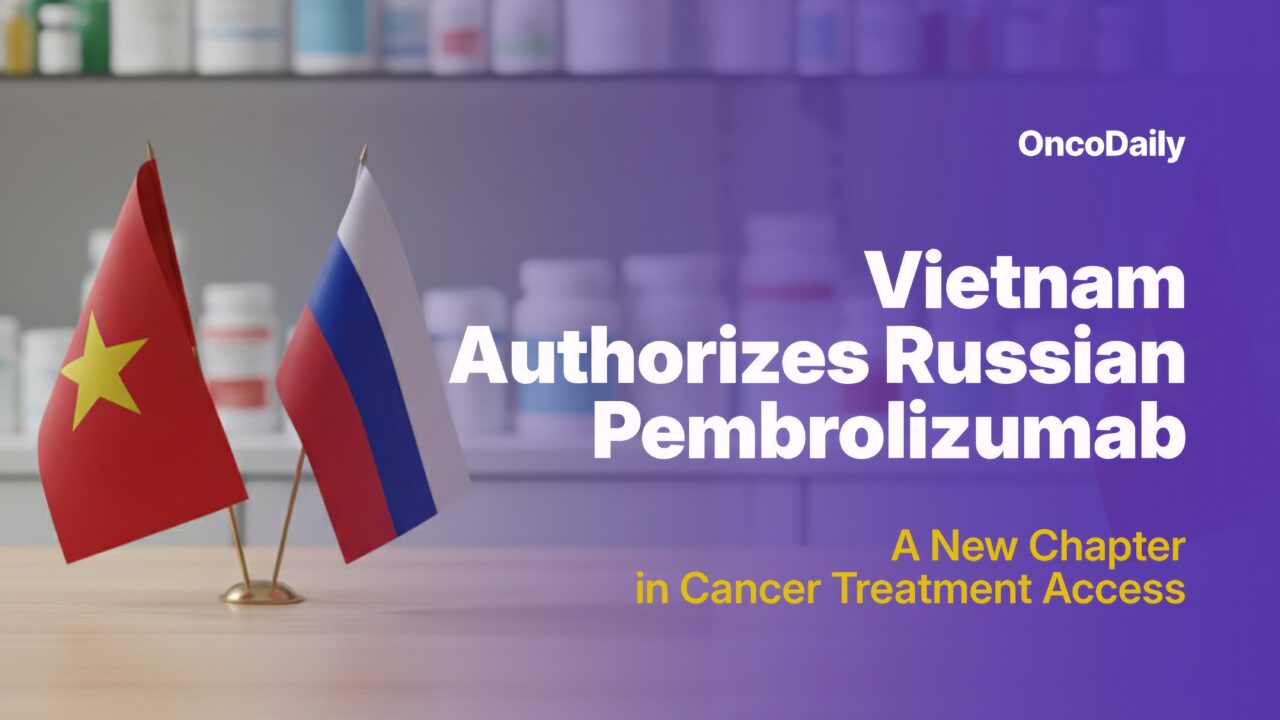Between rhetoric and reality: dignified health care for the Soliga adivasi community in Chamarajanagar district, Karnataka, India | International Journal for Equity in Health

To structure the qualitative data in the results section, the analysis was organised around key thematic categories derived from the core attributes of dignified health care identified in the literature. Each attribute, such as addressing structural violence and social determinants of health, autonomy, informed consent, privacy, confidentiality, non-discrimination, respectful communication, recognition, empathetic engagement, and participatory health governance, served as a theme. Participant narratives, field notes, and texts from the meeting and workshop reports were then grouped within these thematic categories. This approach ensures analytical coherence, allowing the empirical data to reveal how violations of dignity are experienced by Soliga Adivasi communities, manifested, and sustained in practice.
Addressing structural violence, social determinants of health, and broader inequities
Except for a few (n = 3), a majority of the Soliga participants were living in conditions marked by irregular incomes, inadequate housing, and limited access to food (despite the availability of government public food distribution systems and nutrition programmes), health care, and education. Most participants lived in small homes, often temporary shacks constructed from mud and local materials and worked as landless labourers. Many Soliga participants who were interviewed, as well as those attending community meetings, reported that accessing formal health care often required borrowing money, selling personal belongings, or relying on informal support networks. Some leveraged government social health insurance schemes, such as Ayushman Bharat Arogya Karnataka (hereinafter referred to as ABArK), with the support of a local NGO hospital, VGKK. Indirect health care costs for travel and food remained burdensome for many participants. Several Soliga participants, engaged in this study, residing deep within forest areas, often faced limited access to roads, essential services, and stable livelihood opportunities. During the workshop, participants reflected that their traditional way of life was increasingly at odds with the modern conservation agenda implemented by forest officials. Consequently, many Soliga individuals were forced to seek daily-wage labor in nearby coffee and pepper plantations owned by wealthy estate owners, or migrate to other districts and states for seasonal work. Ironically, while environmentalists appeal to the powerful to protect fragile ecosystems, forest-dwelling communities like the Soligas are simultaneously being lured, or coerced, into abandoning their ancestral lands, where generations have lived in harmony with the forest and its wildlife.
For those who migrate, social protections are non-existent. One young Soliga man in his early 20 s, for instance, sustained serious chest injuries after falling from a tree while working on a plantation in Kodagu. According to his brother, the plantation owner refused responsibility, and the injured worker had to rely on the VGKK hospital and a few individuals to access care in both public and private facilities during a year-long recovery.
Those who remain in forest settlements faced growing man-animal conflict. One woman participant described how elephants and leopards frequently roam near her small one-room house with a tiled roof. Her family, including a toddler, must exercise extreme caution, particularly at night, even for basic needs like using the toilet. During community meetings, multi-stakeholder forum meetings and health care providers of VGKK hospital expressed concerns about school dropouts and the poor quality of public education in Soliga Adivasi villages.
During reflections shared after the Image Theatre session at the workshop (Fig. 2), a few participants noted that corrupt practices, such as informal payments to health care providers and staff in public health facilities, act as a barrier to accessing medical care for Soliga communities. These experiences are not isolated misfortunes but manifestations of structural violence, systemic harm embedded in policies, economies, and institutions that marginalize vulnerable communities. The pressures of displacement, lack of health care protections, denial of labor rights, and exposure to ecological risks are all rooted in broader power structures that favor conservation and economic development over Adivasi rights and well-being.
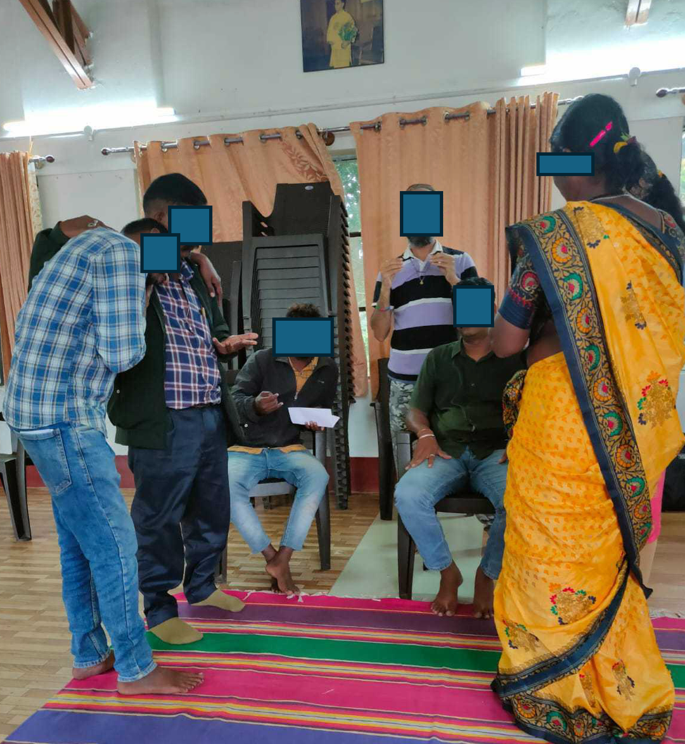
Photograph from the Image Theatre session held as part of the workshop with community leaders and members
The physical and social environments in which the Soliga people live fundamentally shape their health care experiences. These conditions influence how they perceive, internalize, and articulate, if at all, their sense of dignity within formal health care settings. These lived realities also highlighted how social determinants of health, such as income, housing, education, environmental safety, and social exclusion, profoundly affect the lives of Soliga. Ensuring dignified health care, therefore, requires addressing these structural and social barriers that continue to perpetuate inequality and injustice.
Respectful communication
A few participants during the interview indicated that the communication of health care providers and staff towards care-seeking individuals in the hospitals is condescending. Such behaviours are explicitly offensive to the dignity of Soliga individuals. Soliga’s cultural values emphasise respect, relationality, and mutual recognition. In Soliga ways of life, every being, human or non-human, is seen as part of an interconnected web of life, deserving of acknowledgement and care. To be treated as invisible or object-like in a hospital setting violates these relational norms and reinforces a sense of exclusion from the very systems meant to offer healing. The following quote by a health care provider of the VGKK hospital illustrates disrespectful communication experienced by Soligas in health care facilities.
There have been many a time when we send patients to the district hospital, and they get admitted to men’s or women’s wards. The morning rounds will happen, and after that, nobody will touch them, see them, or talk to them, and they feel like they’ve just been thrown here. You know, like nobody, they feel like ‘the NGO hospital VGKK couldn’t take care of me. So they’ve thrown me into this hospital. Here also, nobody is looking at me. The doctor is not coming. Why should I be here?’ Within two days, they get discharged against medical advice and leave”- Health care provider, NGO hospital VGKK.
Another woman participant who was admitted to the district hospital for severe anaemia following an abortion at home expressed her frustration with unresponsive communication from doctors and nurses in the tertiary-level health care facility.
“I was five months pregnant. I had an abortion at home. I did not go to the hospital after that. After three days, a health worker from VGKK hospital visited my home; she advised me to go to a hospital immediately since I had severe swelling in my body. I got admitted to a government hospital in the Chamarajanagar district. The doctors told me that I may need a blood transfusion. Even after waiting for 13 days in the hospital, a blood transfusion was not done. There was no information. The doctor or the nurses won’t speak much, even though we ask them. I felt frustrated. The staff at the hospital are not ready to listen to us. My husband is an alcoholic; my mom sold the cattle to organise medical care here in this hospital. People like us should never go to big hospitals like that. What kind of doctor is he if he is not able to understand my (health) problems?”- Woman, early 20s, BR Hills.
The next quote highlights how individuals seeking care are left without proper communication or guidance in public health care facilities.
“My mother and I used to stand in the queue for 2–3 hours. If we came out of the line, again we had to stand for another 2–3 hours (to submit the required documents to avail the social health insurance benefits)…, but I don’t know that ABArK (social health insurance) office”- Family member of a woman care-seeking individual admitted at a government hospital (a 35-year-old man), BR hills.
The capacity to negotiate with the health care providers at the government hospitals, even for the medical doctors of VGKK to organise care for Soliga Adivasi individuals, proved to be a demanding task. A medical doctor working in VGKK expressed that
“If it is difficult for a medical doctor to have conversations with another medical doctor, things could be much worse for the care-seeking individuals”.
“These two patients, unfortunately, were out of our trust. The moment we sent them to Mysore. We don’t have any interns, and we don’t have a tribal health navigator in Mysore. The only conversation I can have is with the PG over there or the Senior Resident doctor consulting. Most of the time, they are not interested in picking up my calls, also because maybe they have so many patients to look after. I don’t know their reasons for it, but for them to have a conversation say about one patient, they feel they don’t need to have this conversation, so they don’t want to talk about it, maybe, so I understand what the patient feels because if the doctor is speaking to me like this, so it might be a whole other level with the patient”- Medical doctor, in their late 20s, NGO hospital VGKK, BR hills.
These instances collectively underscore how inadequate, impersonal, and often dismissive interactions are widespread in health facilities.
Autonomy/informed consent
Respecting autonomy means providing clear, comprehensive information so care-seeking individuals can make voluntary, informed choices. At government hospitals, information desks and large posters promoting social health insurance schemes, aiming to guide care-seeking individuals and their families, are a common sight. However, despite their willingness and attempts to engage with these schemes, none of the Soliga participants and their family members engaged in this study were able to independently complete the necessary paperwork without the NGO staff support during hospitalisation. There is a systemic lack of proactive information dissemination by the government in Adivasi villages regarding health insurance schemes, hospital procedures, and available health programs. As a result, people are often left to navigate the complexities of the health system on their own, usually only discovering critical information when they reach a hospital, often in moments of vulnerability or crisis. Drawing from the authors’ PNS and TS own experiences in organising care for Soliga communities, as well as insights shared by VGKK hospital staff, hospital procedures were complex and inaccessible for many Soliga people without the active support of VGKK staff. One participant, who accompanied his mother to a district-level government hospital, expressed a resigned understanding that being poor meant having fewer choices(thus restrictions in their autonomy), and that seeking free health care often required enduring long delays, even in serious situations.
“… I don’t know that I have to get signatures from 2–3 officers in the required document. So I was standing in the queue to get the bill for MRI scan, thinking that I had the signed document with me. After seeing the document, the staff at the counter asked me to go to another counter to get the bill. When I went to the other counter after standing in the long queue, the staff at the new counter told me to go to another office near the eye hospital to get the signature on the document. Then I went to that counter, thinking that it was the ABArK office and asked the staff there in the office. The staff took the photocopies of the Aadhar card, ration card, and other documents from me and put the seal and signature. My mother and I used to stand in the queue for 2–3 hours; if we came out of the line, again we had to stand for 2–3 hours. So… I paid the full charges for the MRI scan, thinking that at least then the staff would do the MRI scan early for my mother”-Family member of a woman care-seeking individual who was admitted to a government hospital, her late 20s, BR hills.
When people are forced to depend on charity for basic needs, it can feel like a loss of autonomy and always keep them in a position of dependence at the cost of their inherent dignity and rights. Accessing health care for many of the Soliga participants (as indicated in interviews and community meetings), even in dire medical emergencies, constantly required leveraging social networks and support from charity and NGO intermediaries who know the health system well to be able to use it. A few participants of the workshop indicated that people who get respect during visits to health care facilities are typically those who are socially connected to health care providers. But their narrations indicated that to even get noticed by a health care provider, the care-seeking individuals and their family members have to constantly be open about their networks, NGO support and assert it to the health care providers and hospital staff while seeking health care. The experiences of Soliga participants highlight how bureaucratic and institutional barriers severely undermine patient autonomy and limit access to essential information needed to make informed decisions about medical care.
Non-discrimination, recognition and empathetic engagement
In the context of health care delivery, where health care providers did not have long-standing relationships with Soliga communities or were not sensitised to their socio-cultural realities, health care experiences for the Soligas were marked by discrimination and a lack of recognition as individuals and empathetic engagement. See, for instance, the following situation. While waiting in the inpatient ward of a public health facility to interview a family member of a Soliga woman admitted for evaluation of a severe headache, MP observed a distressing situation. The patient and her family had travelled from a remote Adivasi village deep within the forest. Her son described how they had been waiting for nearly three days to get an MrI scan done. Each day, his mother was instructed not to Drink water from 6 am onwards in preparation for the scan. Yet, for two consecutive days, she was taken to the MrI room, made to wait until 3 p.m., and then sent back to the ward without the scan being completed. Each time, a vague reason was given, and the process was repeated the next day.
Noting the growing distress and the mother’s worsening condition, particularly the combination of prolonged fasting and severe headache, MP suggested accompanying the son to speak with the in-charge nurse to seek clarity about the delay. However, the son hesitated, expressing fear that he would be scolded by the staff. He admitted he was afraid to approach care providers or question them in any way.
MP then approached the nurse on his behalf, explaining the family’s living conditions and the difficulty they faced in accessing hospital care from such a distant and isolated location. She emphasised the urgency of the scan, given the mother’s condition and prolonged fasting. In response, the nurse said, “What can I do? I have also worked in tribal areas for 15 years. I know about their life. There are so many patients, we cannot say when the scan will be done.” A resident doctor, sitting beside the nurse and writing in a patient file, added without looking up: “This is a government hospital; things will be delayed a bit. This is what can be expected here.”
After this exchange, the nurse turned to the son and, in a sharp tone, asked, “Why are you bringing people to question me? You could have come and asked yourself.” The son, visibly embarrassed and hurt, lowered his gaze and remained silent.
This encounter reveals how discrimination, lack of recognition, and absence of empathetic engagement shape the health care experiences of the Soliga community. The son’s fear of approaching staff reflects internalised marginalisation, while the staff’s dismissive and rude responses highlight institutional indifference. Despite the family’s hardship and the mother’s worsening condition, their concerns were minimised, and their dignity was overlooked. Such interactions expose systemic power imbalances and a broader failure to treat Adivasi people as equals and deserving participants in care.
The following quotes reflect the navigational challenges, fear, and vulnerability experienced by Soliga care-seeking individuals and caregivers when accessing care. The reliance on literate intermediaries and NGO staff underscores not only barriers related to literacy and bureaucracy but also a lack of empathetic engagement from health care providers.
“If we go alone from here, we have to spend money for the bus, in hospital they say a hundred things like go here and there, get the token, letter, get sign here etc, we don’t know all those things because we have not read, and we can’t do all those things they say, so it is better to take a person who is literate, since they can do all the work easily for us.”- Grandfather of a 15-year-old girl with Type I Diabetes Mellitus.
“My mother is there to support me. But she can’t do all that (in hospital) because they say go here and there for scans, blood tests and other things, so I didn’t go”- a woman with a chronic health condition, Late 30s, BR hills.
If we go (to hospitals outside BR hills) without the staff support of the NGO hospital VGKK, we will have fear thinking what will happen, what they (health care providers) will do”- Grandmother of a 15-year-old girl with Type I Diabetes Mellitus.
A few participants had perceived differences and distanced themselves from the care providers and hospital staff because of the attitude of health care providers and hospital staff, and existing patient care practices in the hospitals.
“If the doctor asks only, I will say otherwise; I won’t say. Mostly doctors just ask what is the health problem I’m facing, and they just give tablets and medicine for that. They are not interested in knowing my life or sorrows”- a woman with a chronic health condition, late 30s, BR hills.
“There is some social conditioning that happens as children and adults among these people, which tells them under no circumstances to trust the outsider. I mean, I’m not talking about you, but many of us who are working there as doctors and all the formal health care establishments are outsiders. They did not believe, very recently, even ANMs and Nurses. Only now they’ve begun to see that my kind of person is also a health care provider”- Medical doctor, who lived in the BR hills and worked with Soliga communities for more than a decade.
Following an Image Theatre (Fig. 3), community members expressed that despite enduring long waiting times, sometimes stretching into weeks, they continued to seek consultations with senior doctors, diagnostic tests, and necessary treatments. However, their capacity to persist was tested by the lack of timely information and communication from the health care providers. Without updates or explanations, many felt disoriented and excluded, leading to a deep sense of uncertainty. The above experiences of Soliga’s highlight a serious gap in empathetic engagement within the health care system. Participants were not simply waiting for services; they were waiting in a void, without recognition of their presence, time, distress, or dignity.
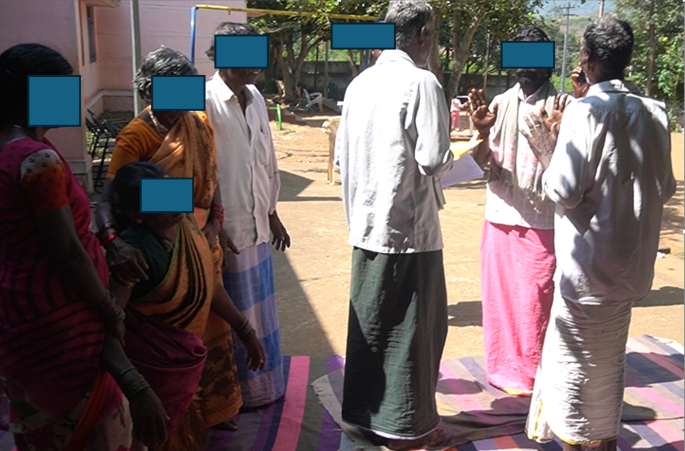
A photograph from the Image Theatre performed by Soliga community members during a community meeting
These experiences reflect how deeply rooted social hierarchies, fear, and unfamiliarity with formal systems contribute to feelings of exclusion and perceived discrimination among the Soliga communities. Despite needing care, individuals hesitate to speak, seek help, or access services without support, fearing judgment or mistreatment. The lack of culturally sensitive engagement from health care providers reinforces mistrust and perpetuates a sense of “othering.”
Privacy and confidentiality
For several Soliga participants we interviewed, as indicated earlier, accessing health care often involves seeking support from NGO hospital workers or others who can assist them, either financially or by helping them navigate the health care system. This means that each time they attempt to access medical care, they are required to disclose their health or illness status to multiple people, potentially compromising their right to privacy and confidentiality.
In crowded public health facilities, Soliga individuals have little or no opportunity to discuss their medical issues in private. However, this does not imply that breaches of privacy or confidentiality are acceptable within Soliga communities. On the contrary, such violations can have devastating consequences for individuals and their social well-being.
For example, during an Adivasi Arogya Samvada meeting, a community member criticized a community health officer (CHO) behaviour for publicly revealing the sickle cell disease diagnosis of a 16-year-old Soliga boy in front of his schoolmates and teachers. As a result, the boy felt deep shame and began to fear the disease’s potential complications, even though he was asymptomatic at the time. Having witnessed his father’s suffering and multiple hospitalizations due to the same condition, the boy believed he would suffer a similar fate. He stopped attending school and feared he would never get married, as his diagnosis had become public knowledge. The community leader pointed out that the CHO should have been more cautious and taken a more empathetic approach rather than disclosing the boy’s medical condition in a public setting.
In another instance, during a discussion between local community leaders and health care providers at a Primary Health Centre, a health care worker openly stated that a community leader had tuberculosis (TB) and was not coming for treatment. Other Adivasi leaders present at the meeting immediately objected, stating that it was inappropriate to name the individual and disclose his health condition in front of others. The health care worker defended the action by arguing that public knowledge might motivate the individual to seek treatment. While this reasoning may appear logical, it nonetheless constitutes a clear violation of privacy and confidentiality.
Accessibility and culturally appropriate care
A few participants felt that they were simply denied care for no reason. A few others felt that the treatment was inadequate and inappropriate given the seriousness of the medical problem they had.
“We don’t know what the reason is, but they were not admitting. When we asked anybody in the hospital, they used to say stay here, only the doctor has not come yet. Whenever we asked to admit, they used to say Wait”- Family member of an ANC mother in a government hospital, early 40s, BR hills.
“The treatment wasn’t satisfactory. They would administer painkiller injections but did nothing else in the government hospital in Chamarajanagar,”- Family member of a man (early 20 s) who sustained a serious chest injury due to a fall from a tree while working in a coffee plantation.
All participants from the Soliga community faced financial hardships in accessing care despite the social health insurance programmes of the government. Their experiences reflect not just economic hardship, but also a violation of their sense of dignity. As indicated by community leaders and members during a discussion following an Image Theatre session, informal payments for free services in public health facilities and exorbitant fees in private health care facilities were common issues. Their narratives underscore that financial barriers are not merely transactional, but they are deeply tied to how individuals are seen, treated, and respected within the health system. Financial hardship emerged as a central concern among Soliga participants in their efforts to access timely and appropriate medical care.
“I couldn’t go due to money problems even though I was seriously ill”- a woman in her late 30s, BR hills.
“Whether it is a government or a private hospital, we should have money in our hands before going; without money, we can’t go. Where do we get money? Barely we have half acre of land, our survival is based on that”- Grandmother of a 17-year-old girl with Type I diabetes, BR hills.
“At a big (private) hospital, they did 3 operations. We paid INR 70,000. X mam from the NGO, helped us. There was a name problem on the social health insurance card until we paid the money; they were taking care of all the facilities[i.e., the hospital provided good care and full attention when they were paying out of pocket]. But when the error in the health insurance card was rectified and my brother was eligible to avail the treatment under the social health insurance scheme, poor treatment was meted out to my brother [i.e., once the payment was to come from the government insurance scheme, the hospital’s attitude and quality of care worsened]. So we got him discharged from the hospital”- Family member of a care-seeking individual who underwent major surgeries in a tertiary-level private health facility in Bengaluru, a man in his late 40s, BR hills.
All Soliga Adivasi individuals and their family members who were part of this study had to make elaborate arrangements in terms of money, travel, and family support for seeking care in hospitals that are located far away from their villages. For instance, for a person who is living in Beduguli, a remote Soliga village in BR hills, it would take 2–3 h (which can vary depending on road conditions in the forests, weather, and vehicle availability) to reach the district hospital in Chamarajanagar. Due to limited public transportation, community members rely on private vehicles in times of illness and medical emergencies. Each such trip can cost around INR 4000–5000 (USD 45–60). Most of them utilise services from government hospitals if they need secondary or tertiary care. A few participants reported seeking care from private health care facilities despite financial hardships with the hope of finding a cure for their ailments. For major surgeries, a few participants had sought the help of NGO hospital VGKK to utilise the public social health insurance scheme (ABArK) and/or to navigate the private medical care system when services were unavailable in public health facilities or where long waiting periods made timely care unattainable.
During the discussions following the Image Theatre session at the workshop (Fig. 4) with community leaders and members, a few participants shared that poor road infrastructure, limited mobile network coverage, and inadequate ambulance connectivity in remote Soliga Adivasi settlements often lead to delays in accessing health care. They linked these challenges to a lack of coordination among various departments, including the Forest Department, Transport Department, and Health Department. Even with support from the NGO hospital VGKK staff, IPH Bengaluru staff and Adivasi leaders from the community-based organisations, when they reached the hospitals (especially government hospitals), they had to wait for hours and days to get basic investigations and treatment done. See, for example, the following quote,
“ My mother got admitted to this hospital (government) on Monday. Two staff members from an NGO hospital, VGKK, came with us and made all arrangements for my mother to get admitted here. In the hospital, we were told that an MRI scan had to be done. But they kept postponing the date. Even the NGO staff called the concerned people here at this hospital. Five days have passed, but the MRI scan is still not done…They won’t do anything on holidays ”- Family member of a woman care-seeking individual who was admitted to a government hospital, in their late 20s, BR hills.
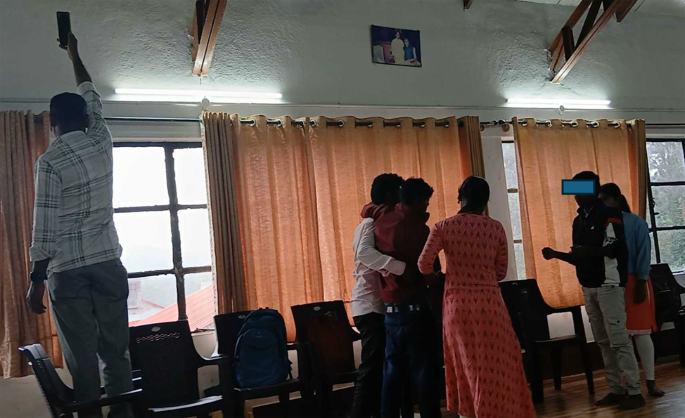
A photograph from the Image theatre session conducted as part of the workshop with community leaders and members
For a Soliga living in the forest or in the fringes of the forest, delays and long waits in accessing medical care in cities can severely undermine culturally appropriate care. The health care facilities situated outside the forest areas often operate in ways that are unfamiliar and uncomfortable, creating a cultural disconnect that can lead to feelings of alienation and anxiety. Long waiting times can also disrupt the individual’s connection to traditional healing practices and community support, which are often central to their understanding of health and recovery. Moreover, being away from their environment for extended periods may interfere with important cultural responsibilities, adding further stress. See, for instance, in the words of a young Soliga mother who admitted her child, who was prematurely born at home, to a secondary health care public facility,
“They are asking me to go to another city, Mysuru, with my child, since there is no treatment for my child’s sickness at this facility. I cannot stay too long outside my home (which is in a remote forest area). I feel anxious and shy to talk to the hospital staff. Here, at least, there is a tribal health navigator who helps us with the hospital procedures. In Mysuru, we will not have such people to help us. So I do not want to go.“– Mother of an infant child admitted in a secondary health care public health facility.
Participatory health governance
Participatory health governance ensures that marginalized communities have a voice in shaping health systems, leading to more responsive and respectful care. When communities are actively involved in decision-making, health care delivery is more likely to uphold dignity, cultural relevance, and accountability. Throughout the participatory action research process, including community workshops, meetings with local leaders, and ongoing engagement with Adivasi collectives in Chamarajanagar district, significant barriers to participation in health governance spaces were observed. These included limited or no access to decision-making forums such as Village Health, Sanitation and Nutrition Committees (VHSNCs). Health care providers and government officials from other sectors often viewed communities primarily as passive recipients of services, rather than as active stakeholders. For example, during a multistakeholder meeting in one gram panchayat (the basic unit of rural local self-government in India), frontline health workers and government representatives emphasized health education as a tool to secure community compliance with government schemes, rather than promoting meaningful dialogue or accountability. Several community members, both Adivasi and non-Adivasi, reported limited awareness or memory of participating in any structured meetings dedicated to reviewing the state of local health services. While gram sabhas (village assemblies) are held at the panchayat level, they are not typically focused on health-related issues and rarely facilitate inclusive discussions on health service quality or access.
During a community-level meeting, a participant from a local collective noted the importance of being informed about their rights to claim them, emphasizing that inclusion in decision-making bodies is essential for holding the system accountable. In a separate Image Theatre session (Figs. 5, 6 and 7), several participants shared frustrations with bureaucratic follow-up processes, particularly in areas such as forest rights implementation. These processes often required persistent engagement over long periods, sometimes years, with little progress unless pressure came from higher authorities. As a result, participants described strategies such as bypassing local officials to approach senior administrators directly or mobilizing in large groups to ensure their concerns were taken seriously. They expressed a strong sense that individual voices were frequently dismissed unless amplified through collective action.
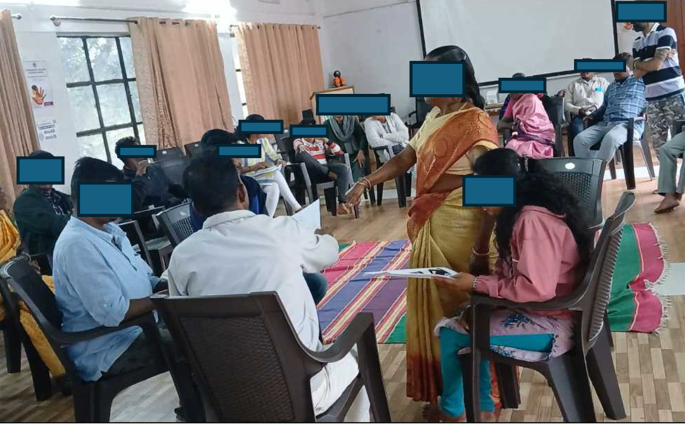
Photographs from the Image Theatre session with Soliga community leaders and members, which opened up critical discussions concerning health governance realities for Soliga communities
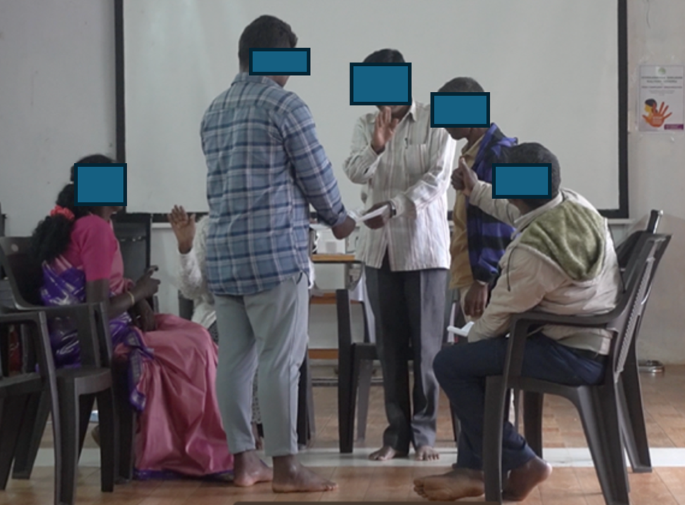
Photographs from the Image Theatre session with Soliga community leaders and members, which opened up critical discussions concerning health governance realities for Soliga communities
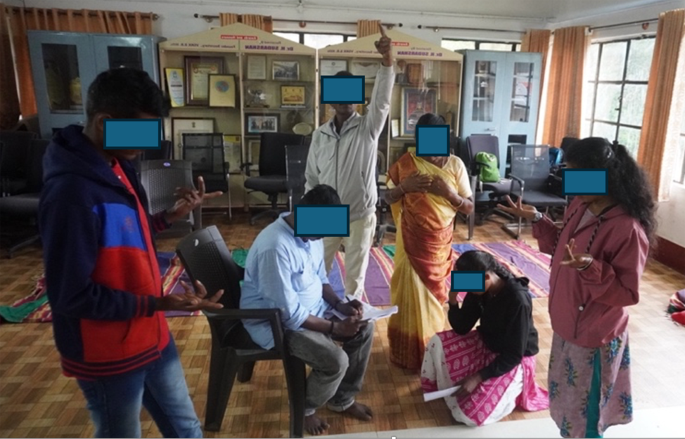
Photographs from the Image Theatre session with Soliga community leaders and members, which opened up critical discussions concerning health governance realities for Soliga communities
The health care experiences of the Soliga community illustrate how the failure of participatory health governance creates a disconnect between health systems and the lived realities of marginalized groups. When community voices are excluded from decision-making, care becomes impersonal, exclusionary, and often disrespectful, reinforcing existing power imbalances, disregarding cultural contexts, and ultimately undermining the dignity and autonomy of those seeking care.
link


